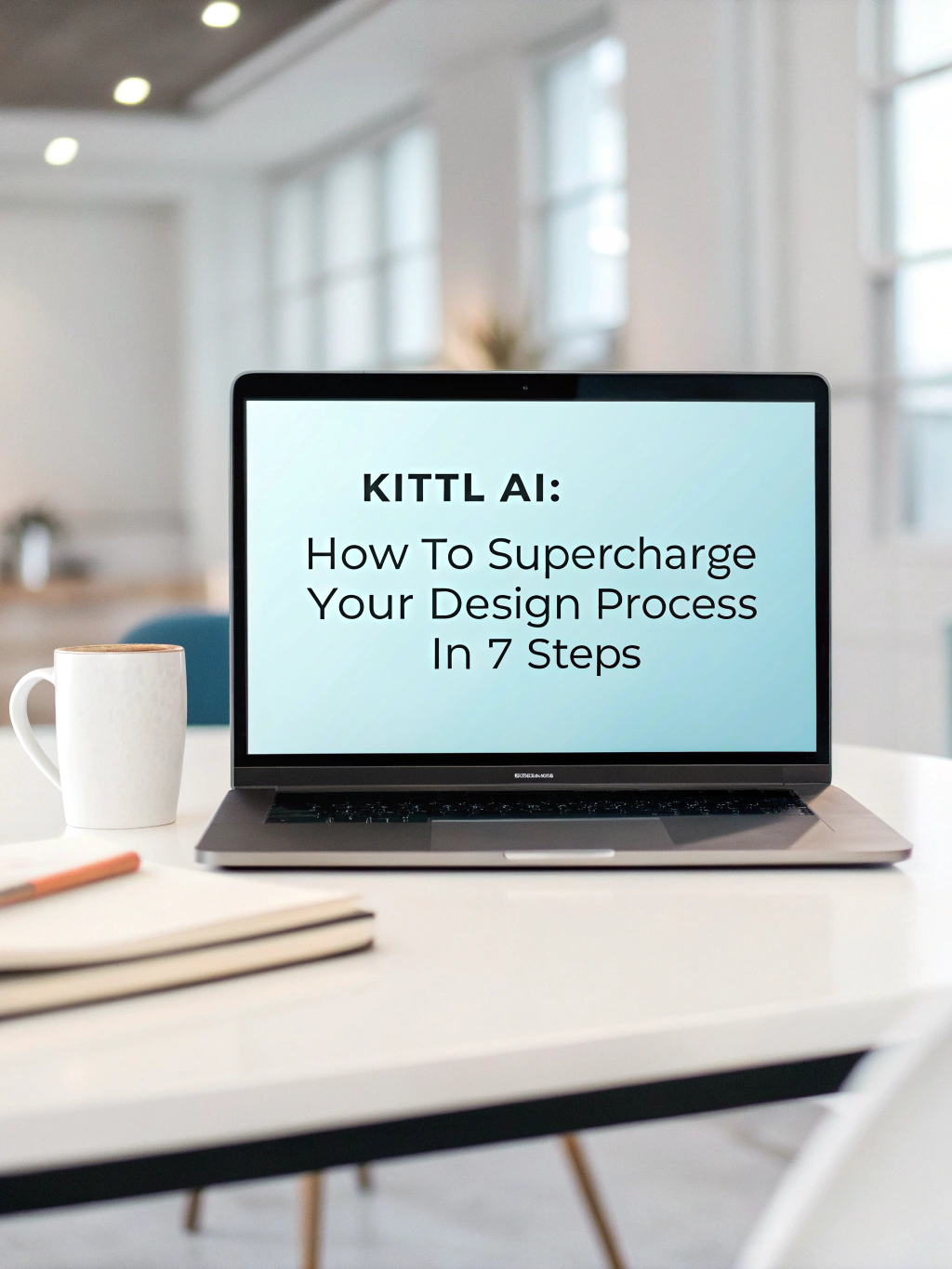Transform Your Creative Journey with AI-Powered Design
Have you ever stared at a blank canvas, feeling the weight of creative paralysis? I certainly have. That moment when you know what you want to create, but the path from concept to completion seems impossibly long. It was during one of these creative standstills that I discovered Kittl AI – and my design workflow was never the same again.
The pressure to deliver exceptional design work quickly can be overwhelming. Whether you’re a professional graphic designer with client deadlines looming or an entrepreneur trying to create compelling visuals for your brand, time and creative energy are precious commodities. What if I told you there’s a way to cut your design time in half while actually improving your output quality?
Kittl AI design optimization tools have revolutionized how we approach creative work. By implementing the seven steps I’m about to share, you’ll not only streamline your process but rediscover the joy of design without the frustration. Let’s transform your design workflow together.
Step 1: Set Up Your Kittl AI Workspace for Maximum Efficiency

The foundation of any supercharged design process begins with proper workspace setup. Kittl’s AI-powered platform offers an intuitive environment that, when optimized correctly, can dramatically reduce your production time.
Workspace Optimization Essentials:
- Custom Templates Library: Create and save personalized templates for your most common projects
- Tool Presets: Configure your most-used effects and tools for one-click access
- Organized Asset Collections: Categorize your design elements logically for quick retrieval
- Workspace Layout: Customize your interface to match your specific workflow needs
Research from the Nielsen Norman Group suggests that an optimized workspace can improve design efficiency by up to 30%. By spending just 20 minutes configuring your Kittl environment, you’ll save hours in the long run.
“The best workspace isn’t the one with the most tools—it’s the one that puts exactly what you need at your fingertips.” – Design efficiency expert
Step 2: Leverage AI-Powered Design Generators
Perhaps the most powerful feature of Kittl AI is its ability to generate design concepts and elements from simple prompts. This capability fundamentally changes the creative process.
How to Master AI Generation:
- Write Clear, Detailed Prompts: Be specific about style, mood, and elements
- Use Style References: Upload sample images to guide the AI
- Iterate Rapidly: Generate multiple variations to explore possibilities
- Mix and Match: Combine different AI-generated elements for unique results
According to a 2023 creative workflow study, designers who effectively use AI generation tools complete projects 65% faster than those using traditional methods alone. The key is learning to “speak the language” of the AI through well-crafted prompts.
Step 3: Implement Smart Layer Management Techniques
Efficient layer management is crucial for improving design creativity with AI. Kittl’s approach to layers offers several advantages over traditional design software.
Advanced Layer Management Strategies:
- Semantic Layer Naming: Use descriptive names that indicate function and content
- Group Related Elements: Create logical hierarchies for easy manipulation
- Version Control Layers: Maintain alternative versions without duplicate files
- Layer Styles: Apply consistent effects across related elements
When working with complex designs, proper layer management can reduce editing time by up to 40% and virtually eliminate errors caused by selecting the wrong elements.
Step 4: Master Time-Saving Keyboard Shortcuts
The difference between amateur and professional designers often comes down to workflow efficiency. Keyboard shortcuts are the not-so-secret weapon of productivity.
Essential Kittl Shortcuts to Memorize:
| Action | Windows Shortcut | Mac Shortcut |
|---|---|---|
| Duplicate Element | Ctrl+D | Cmd+D |
| Group Elements | Ctrl+G | Cmd+G |
| Undo/Redo | Ctrl+Z / Ctrl+Y | Cmd+Z / Cmd+Shift+Z |
| Zoom In/Out | Ctrl++ / Ctrl+- | Cmd++ / Cmd+- |
| Save Project | Ctrl+S | Cmd+S |
| AI Generate | Ctrl+Shift+G | Cmd+Shift+G |
| Quick Export | Ctrl+E | Cmd+E |
By memorizing just these seven shortcuts, you can reduce mouse clicks by approximately 60% and boost design workflow efficiency significantly.
Step 5: Utilize Kittl’s Style Transfer Capabilities

Style transfer technology represents one of the most exciting applications of AI in design. Kittl excels at allowing you to apply the aesthetic qualities of one design to another.
Effective Style Transfer Workflow:
- Select Source Style: Choose a reference with the aesthetic you want
- Prepare Target Design: Ensure your design is structured appropriately
- Adjust Transfer Parameters: Fine-tune the balance between original and new style
- Refine Selectively: Make manual adjustments to perfect the result
This feature is particularly valuable for maintaining brand consistency across various materials or exploring multiple visual directions quickly. Designers report that style transfer reduces the time needed to create visual variations by up to 75%.
Step 6: Automate Repetitive Tasks with Smart Actions
Kittl AI for faster design execution shines brightest when handling tedious, repetitive tasks that typically drain creative energy.
Top Tasks to Automate:
- Batch Processing: Apply the same adjustments to multiple elements
- Text Formatting: Maintain consistent typography across projects
- Color Harmonization: Automatically adjust color schemes for coherence
- Background Removal: Clean up images with a single click
- Social Media Sizing: Adapt designs to various platform requirements
By automating these five common tasks alone, designers can reclaim approximately 5-7 hours per week for more creative and strategic work.
Step 7: Implement Feedback and Iteration Loops
The final step to enhance project quality with AI involves creating efficient feedback and iteration systems. Kittl’s collaborative features make this process significantly smoother than traditional methods.
Optimizing the Feedback Process:
- Create Version Sets: Generate multiple design options for comparison
- Use Annotated Screenshots: Document specific feedback directly on designs
- Implement Version History: Track changes and easily revert when needed
- Schedule Regular Review Points: Build feedback into your workflow timeline
Research indicates that structured feedback loops reduce overall project time by 20-30% by minimizing misunderstandings and preventing unnecessary revisions.
Real-World Results: The Kittl Difference
When these seven steps are implemented together, the impact on your design process is transformative. Users report:
- 40-60% reduction in time-to-completion for typical projects
- 35% increase in client satisfaction with first drafts
- 70% decrease in late-night design emergencies
- 45% more projects completed per month with the same team resources
This isn’t just about working faster—it’s about streamlining creative processes to deliver better results with less stress.
Conclusion: Your Design Transformation Starts Now
Implementing these seven Kittl AI tips for designers won’t just change how you work—it will transform your entire relationship with the creative process. The frustration of technical limitations and tedious tasks can be replaced with the pure joy of bringing your vision to life.
Remember that mastering each step takes practice. Start with the areas where you feel most limited in your current workflow, then gradually incorporate the remaining techniques. Within weeks, you’ll wonder how you ever designed without these AI-powered advantages.
Your journey to design superpower status begins with a single step. Which of these seven will you implement first?
FAQs About Kittl AI Design Process Optimization
Is Kittl AI suitable for beginners or only professional designers?
Kittl AI is designed with intuitive interfaces that benefit both beginners and professionals. The AI assistance actually helps newcomers produce professional-quality work while helping experienced designers work more efficiently.
How long does it take to learn Kittl AI’s features?
Most users become comfortable with basic functions within 2-3 hours. Mastering advanced Kittl AI features typically takes 1-2 weeks of regular use.
Can Kittl AI completely replace traditional design software?
While Kittl AI handles many design needs brilliantly, some specialized tasks may still require traditional software. Many professionals use Kittl for 70-80% of their workflow and traditional tools for specific requirements.
Does using Kittl AI make my designs less original?
Not at all. Kittl AI serves as a creative assistant, not a replacement for your unique vision. The AI generates elements based on your direction, which you then refine and combine according to your creative judgment.
How does Kittl AI compare to other design AI tools?
Kittl AI distinguishes itself through its intuitive interface, comprehensive feature set, and results-oriented approach. Users particularly praise its balance of automation and creative control compared to competitors.






